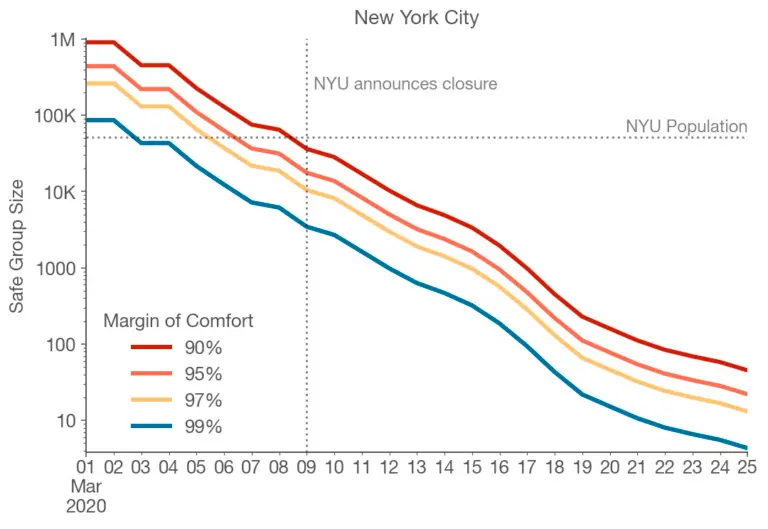TECHNOLOGY| 06.01.2020
Is math capable of changing the future?

By Alvy (Microsiervos)
Kevin Systrom is a computer scientist and millionaire. He is best known for being one of the co-founders of Instagram, a company acquired by Facebook in 2012. He presided over the company from its inception a decade ago until just over a year ago. Since then, he has been involved in other projects, particularly investing in new small businesses and learning about various topics that pique his interest.
Over the past few months, Systrom has spent some time applying his knowledge and experience to analyzing the public data on the coronavirus (COVID-19) pandemic. His approach, which he has already applied at Instagram and on various other projects over the years, is that we can glean a lot from data, develop mathematical models that explain and predict the future—even if the data is imperfect—and in particular, learn how best to act on that data. He sums it up in one sentence:
“If you can predict a thousand possible outcomes on any given topic using a mathematical model, you might better understand what kind of actions are most likely to result in your preferred outcomes.”
In an interview on the Recode podcast, and in a number of articles, he explains it in greater detail. The articles are informative but somewhat technical in nature, and partly based on the math used in fields such as artificial intelligence. The following articles started to appear on March 19, 2020, when there were just 9,000 cases of the virus and very few fatalities in the United States:

The formulas applied by Systrom—who acknowledges first and foremost that he is no epidemiologist—are those that make up the so-called SIR epidemiological model that we see frequently mentioned by experts in the news. These models are simplified versions of the real world, but useful nonetheless to see how an epidemic behaves. The acronym is derived from dividing people into three groups:
- (S) Susceptible
- (I) Infected
- (R) Recovered
The trend of each group (within a certain country, for instance) varies over time, fluctuating up and down and is plotted as the famous curves on a graph, whose shape in turn depends on two variables: the transmission rate and the recovery rate.
Ability to influence the future
Systrom noticed that variables such as the transmission rate resembled those that determine the growth of apps and content on social networks: If 100 people download an app when it is first launched on the market and each of them convinces 2 others to download it, the number of downloads will rise to 200, then 400, 800, 1,600, and so on. This phenomenon is known, as chance would have it, as the “viral effect.” The growth is exponential, rising more or less sharply based on certain well-defined key numerical variables. When these variables change, they produce well-renowned effects such as “flattening” or “bending” the curve.
When these mathematical models are fed real data gathered over time, we can see their impressive predictive ability. In that regard, it helps greatly that there are vast amounts of very detailed information available when it comes to COVID-19. In fact, Systrom hoped he was wrong when the initial results from the model produced extremely high figures based on the little amount of data available on the situation in the United States; in time, he would sadly be proved right. He also understands that these factors are not the same for each country owing to various reasons that are complicated to put into a model.
But the most interesting aspect is that these models can be tweaked to include further details, so-called interventions, including, in the case of COVID-19:
- Maintaining social distancing
- Using face masks
- Putting a city’s population on lockdown
- Restricting travel by car, public transport and airplane
Many countries have implemented these strategies or measures in response to the effects of the disease and in an attempt to return to normality as soon as possible. Systrom compares it to what happens when a new function or extra button is added to an app: Within a few days, studying the data makes it easy to assess whether that measure has been positive or negative.
Trusting the science
Many find it hard to trust in something as cold as data, tables full of numbers, formulas and mathematical models. But it is the best tool available to epidemiologists in determining what may happen in the future. As soon as new data is received on key factors (transmission rate, hospital capacity, recovery rates, mortality, etc.), it can be added and acted on accordingly.
What’s more, owing to the large amount of data available, anyone could, in principle, “choose their own future” — a person may be able to understand the risk of going out on the street versus staying home; or the probability of being infected by meeting up with a group of two, ten or one hundred people. Businesses could even predict the likelihood of an infected person entering their store based on “the time indicated by the curve.”
It is certainly encouraging to know that human intervention can have major influence over the future of a pandemic. Although models sometimes consider variables such as transmission rate to be static, this depends on people’s behavior. People’s attitudes, healthcare measures and government policies may contribute to reducing the risk, thereby drastically altering the outcome. With this in mind, there is a greater incentive for everyone to respect the measures in place and to act in a coordinated manner during a situation that affects us all.
___Photo: (Cc) Cristopher Michel @Wikimedia
